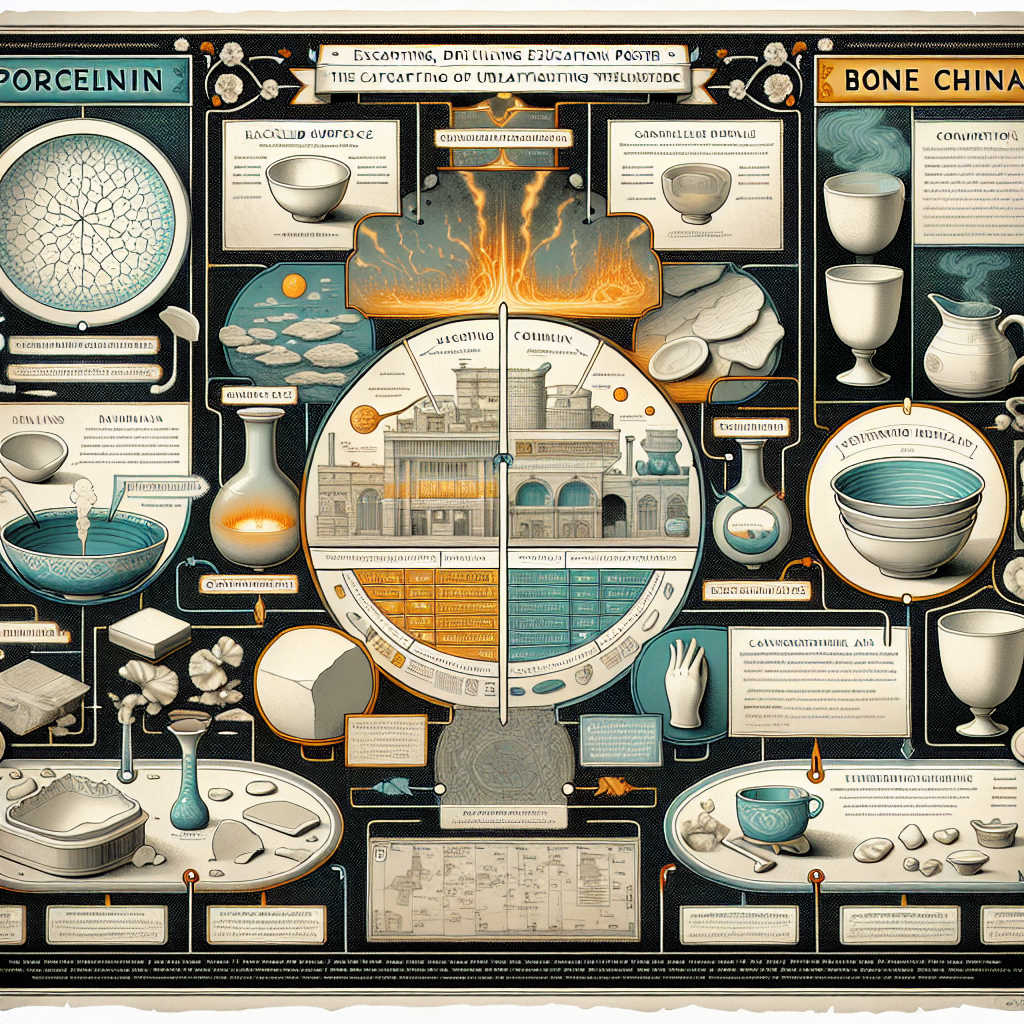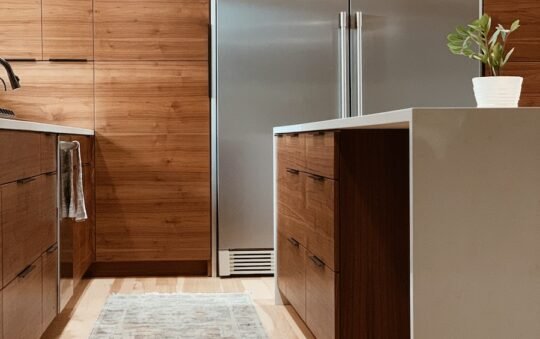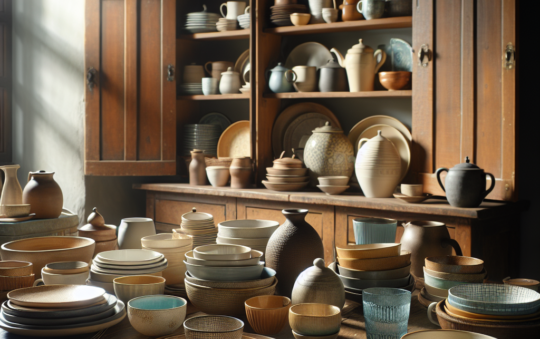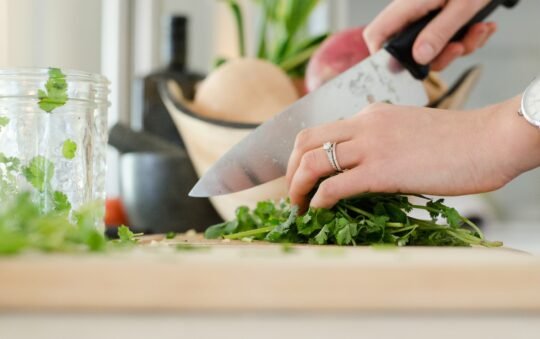Interested in the world of ceramics? If so, you’ve probably come across the terms porcelain and bone china. While they may sound similar, there are actually some distinct differences between the two. Whether you’re an avid collector, an aspiring artist, or simply curious, this article will shed some light on what sets porcelain and bone china apart. Get ready to uncover the unique characteristics and qualities that make these two types of ceramics stand out in the world of pottery. Porcelain and bone china are both popular choices for tableware and decorative items, but they have distinct differences in their composition, manufacturing process, firing temperature, translucency, strength and durability, appearance, weight, usage, microwave and dishwasher safety, and price. Understanding these differences can help you make an informed decision about which material is best suited for your needs. Let’s explore each of these aspects in detail.
Composition
Composition of Porcelain
Porcelain is a type of ceramic made from a mixture of kaolin, quartz, and feldspar. It is known for its delicate and translucent nature, which is achieved through the fine particle size of kaolin and the specific firing process. The composition of porcelain gives it a smooth and glass-like appearance.
Composition of Bone China
Bone china, on the other hand, is a type of porcelain that contains an additional ingredient: bone ash. This bone ash, typically sourced from cattle bones, is added to the mixture of kaolin, quartz, and feldspar. The addition of bone ash gives bone china a slightly off-white color and enhances its translucency, making it even more delicate and elegant.
Manufacturing Process
Manufacturing of Porcelain
The manufacturing process of porcelain involves several steps. First, the raw materials are mixed together to form a clay-like paste. This paste is then shaped into the desired form, such as plates or bowls, either by hand or using molds. After shaping, the items are dried to remove excess moisture.
Once dry, the porcelain objects go through a process called bisque firing, where they are heated at a relatively high temperature to harden the clay and remove any remaining water. After the bisque firing, the items are usually glazed to provide a protective and decorative coating. Finally, the glazed porcelain is fired at an even higher temperature to achieve its characteristic smooth and glossy finish.
Manufacturing of Bone China
The manufacturing process of bone china is similar to that of porcelain, with the addition of bone ash. The bone ash is mixed with the other raw materials to form a paste, which is then shaped, dried, and bisque fired like porcelain. However, due to the presence of bone ash, the bone china items require a longer firing time compared to porcelain.
The longer firing time allows the bone ash to fuse with the other components, creating a highly vitrified material. This vitrification process gives bone china its unique translucency and strength. After the final firing, the bone china items are often glazed to enhance their appearance and durability.

Firing Temperature
Firing Temperature of Porcelain
The firing temperature of porcelain typically ranges from 2,200 to 2,600 degrees Fahrenheit (1,200 to 1,400 degrees Celsius). This high firing temperature is required to fully vitrify the clay and obtain the desired strength and translucency. The firing process also ensures that the glaze adheres well to the porcelain surface and provides a smooth finish.
Firing Temperature of Bone China
Bone china requires a slightly higher firing temperature compared to porcelain. The firing temperature for bone china is typically between 2,300 and 2,800 degrees Fahrenheit (1,260 and 1,540 degrees Celsius). The higher firing temperature is necessary to fully fuse the bone ash with the other components and achieve the characteristic translucency and strength of bone china.
Translucency
Translucency of Porcelain
Porcelain is renowned for its excellent translucency, which allows light to pass through it to varying degrees. The fine particle size of kaolin, combined with the high firing temperature, results in a dense and vitrified material with minimal light scattering. This property gives porcelain a delicate and ethereal appearance that is highly prized in tableware and decorative items.
Translucency of Bone China
Bone china takes the translucency factor to the next level. The addition of bone ash, along with the specific firing process, enhances the natural translucency of the porcelain. The bone ash particles melt during firing, filling any small gaps in the material and increasing its density. This enhanced density allows bone china to transmit even more light, giving it a superior level of translucency compared to porcelain.

Strength and Durability
Strength of Porcelain
Porcelain is known for its strength and durability. The firing process at high temperatures makes the clay particles fuse together, creating a dense and non-porous material. This density gives porcelain its characteristic hardness and resistance to chipping and scratching. Porcelain tableware can withstand everyday use and is often considered more durable than other types of ceramic.
Strength of Bone China
While bone china shares many of the strength and durability characteristics of porcelain, its specific composition and manufacturing process give it a slight advantage. The addition of bone ash reinforces the structure of bone china, making it even more resilient and less prone to breakage than porcelain. Bone china is particularly renowned for its ability to withstand thermal shock, meaning it can handle abrupt temperature changes without cracking.
Durability of Porcelain
Porcelain’s durability extends beyond its strength. The dense and non-porous nature of porcelain makes it highly resistant to stains and odors. It is also less prone to absorb liquids and retain flavors compared to other ceramic materials, ensuring that your porcelain tableware remains in pristine condition. With proper care, porcelain items can last for many years, retaining their beauty and functionality.
Durability of Bone China
Bone china shares the same durability advantages as porcelain. Its denser structure and enhanced vitrification make bone china highly resistant to chipping, scratching, and staining. Furthermore, bone china’s non-porous nature prevents it from absorbing odors and flavors, ensuring that your tableware remains clean and fresh. With proper care, bone china pieces can be cherished heirlooms passed down through generations.
Appearance
Appearance of Porcelain
Porcelain has an elegant and timeless appearance that is characterized by its smooth and glass-like surface. The high firing temperature gives porcelain a bright white color, which serves as a perfect canvas for intricate patterns and decorations. Whether it’s a simple minimalist design or a complex hand-painted motif, porcelain’s appearance exudes a sense of sophistication and refinement.
Appearance of Bone China
Bone china has a unique appearance that sets it apart from porcelain. The addition of bone ash imparts a subtle off-white color to bone china, giving it a warm and creamy tone. This color complements various table settings and adds a touch of sophistication to any occasion. Additionally, bone china’s translucency enhances the appearance of any decorative patterns or motifs, creating a delicate and luxurious aesthetic.
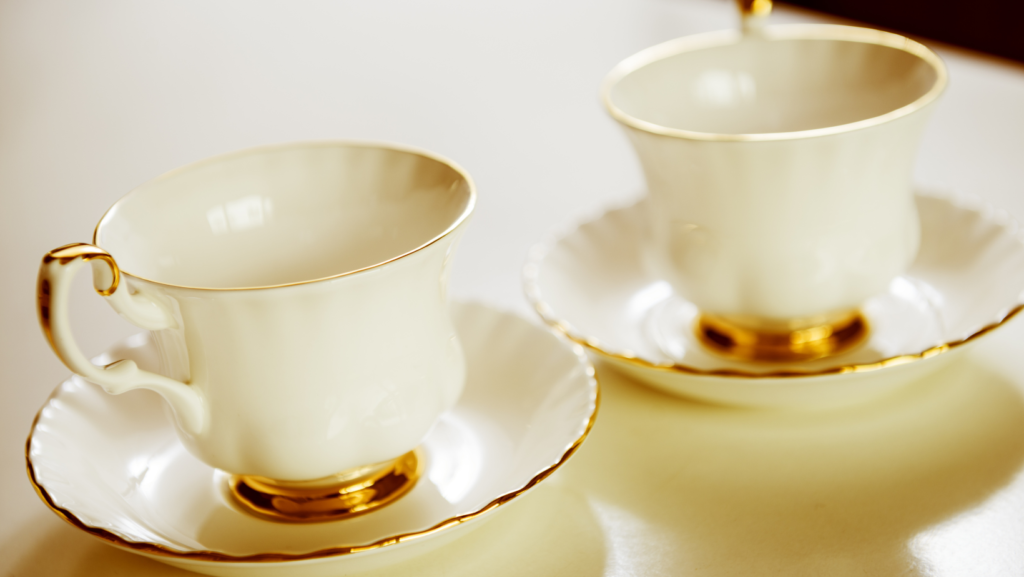
Weight
Weight of Porcelain
Porcelain is relatively lightweight compared to other ceramic materials. The fine particle size of the clay and the high firing temperature result in a dense yet lightweight material. This makes porcelain tableware comfortable to handle and easy to use, especially for longer periods. The lightweight nature of porcelain also makes it suitable for delicate and intricate designs, as it is easier to shape and manipulate.
Weight of Bone China
Bone china shares a similar lightweight quality with porcelain. The addition of bone ash does not significantly affect the weight of bone china, as the bone ash particles contribute to the density rather than the weight of the material. This makes bone china tableware comfortable to hold and use, whether you’re enjoying a leisurely meal or hosting a special occasion.
Usage
Usage of Porcelain
Porcelain is highly versatile and can be used for various purposes. Its strength and durability make it suitable for everyday use, whether it’s for serving meals, drinking beverages, or baking in the oven. Porcelain tableware is also a popular choice for special occasions and formal gatherings, adding an air of elegance to any table setting. Additionally, porcelain’s aesthetic appeal makes it a preferred material for decorative items such as vases, figurines, and ornaments.
Usage of Bone China
Bone china is often reserved for special occasions and formal settings. Its delicate and luxurious appearance, coupled with its enhanced translucency, elevates any table setting and creates a refined atmosphere. While bone china can be used for everyday purposes, its superior quality and elegance are particularly valued for hosting guests or celebrating significant events. Bone china’s timeless beauty also makes it a coveted choice for collectors and those seeking statement decorative items.
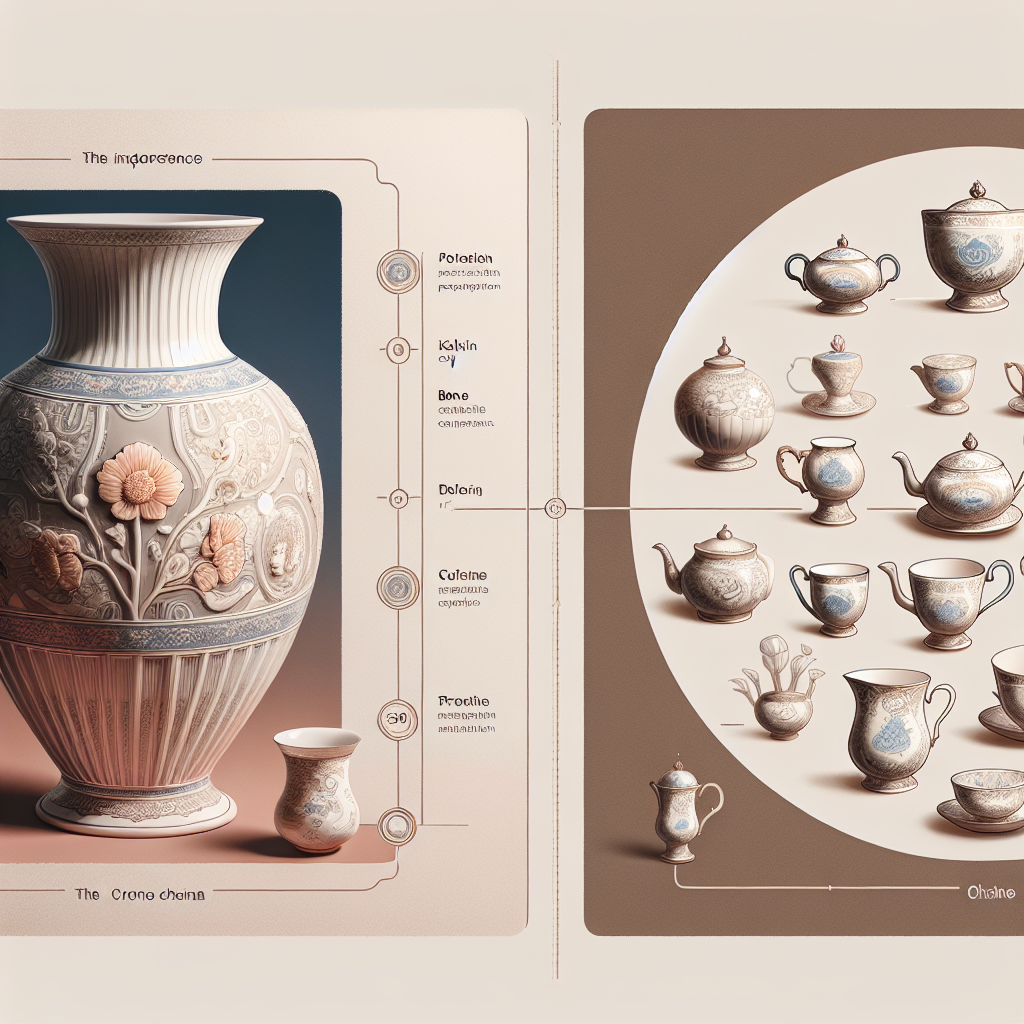
Microwave and Dishwasher Safety
Microwave and Dishwasher Safety of Porcelain
Porcelain is generally considered microwave and dishwasher safe. However, it’s essential to check the specific guidelines provided by the manufacturer, as some delicate or hand-painted porcelain pieces may require more gentle care. For microwave use, it’s recommended to avoid placing porcelain with metallic accents or gold trim, as they can cause sparking. When using a dishwasher, it’s advisable to choose a gentle cycle and avoid overcrowding the dishwasher to prevent potential chipping or breakage.
Microwave and Dishwasher Safety of Bone China
Bone china is typically microwave and dishwasher safe, but it’s important to exercise caution. As with porcelain, it’s advisable to check the manufacturer’s guidelines for specific instructions. While bone china can withstand the microwave and dishwasher, it’s worth noting that its delicate nature may be better suited for gentle hand washing and careful handling to ensure its longevity. Hand washing bone china with mild soap and avoiding harsh scrubbing or abrasive materials is the safest way to maintain its beauty and prevent any potential damage.
Price
Price of Porcelain
The price of porcelain can vary significantly depending on factors such as the quality, craftsmanship, brand reputation, and any additional decorative elements. Generally, porcelain is considered more affordable compared to bone china. However, as with any luxury item, there are high-end porcelain pieces that can command a higher price, particularly those crafted by renowned artists or featuring intricate designs.
Price of Bone China
Bone china is generally considered more expensive than porcelain due to its unique composition, manufacturing process, and exquisite appearance. The addition of bone ash, along with the longer firing time and enhanced translucency, contributes to the higher production cost of bone china. Additionally, the exclusivity and prestige associated with bone china can also influence its price. However, the price range for bone china can vary widely depending on the brand, design complexity, and overall quality.
In conclusion, porcelain and bone china have distinct differences in terms of composition, manufacturing process, firing temperature, translucency, strength and durability, appearance, weight, usage, microwave and dishwasher safety, and price. Porcelain is renowned for its delicacy, strength, and versatility, while bone china offers enhanced translucency, elegance, and resilience. Both materials have their unique charm and application, and the choice between porcelain and bone china ultimately depends on your personal preferences, intended usage, and budget. Whether you’re looking for everyday tableware or exquisite decorative pieces, both porcelain and bone china can bring beauty and sophistication to your home.
